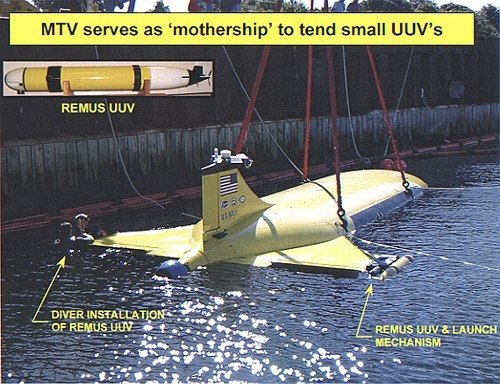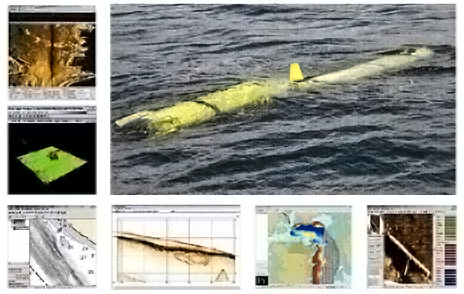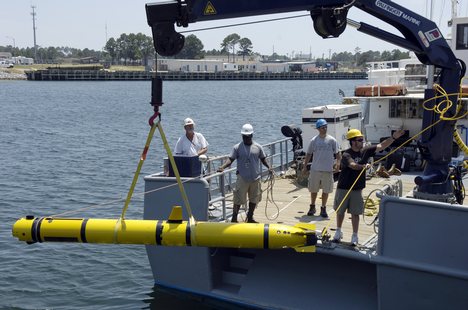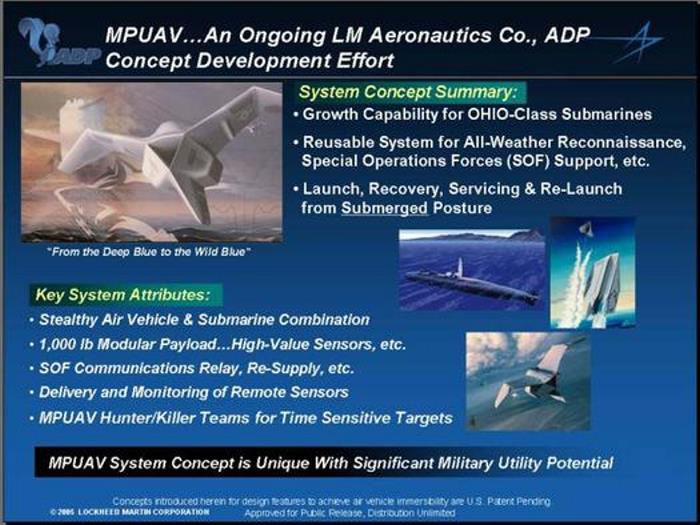|
.. |
||
|
Originally posted by observe50
You sure about that?
Now I have not found any details on this particular craft yet but it sure looks like it can go places "Where no one has gone before" Originally posted by wdpk OM Post ID 288348 Hello zorgon. Thanks a lot for your fascinating researches! I found a lot of informations about the image above: After searching for a while on various Navy websites with webarchive, I found another image of the same craft, and a description of it :
The Naval Undersea Warfare Center works to expand the knowledge of the underwater world, as well as man's ability to work within this environment. The following stories focus on three NUWC projects to aid medical treatment, increase our knowledge of the physical laws of water, and take aim at the 21st century. His eyes were bloodshot, and his head hurt. It reads like a science fiction
novel. But, if a man by the name of John Sirmalis has his way, it won't
be fiction for much longer. Dr. Sirmalis is the technical director at the
Naval Undersea Warfare Center in Newport, R.I., and he is currently developing
the technology to build an unmanned, undersea vehicle capable of extending
the eyes and ears of the Navy's submarine force.
Sirmalis believes the Manta will be deployed as standard equipment on board Navy submarines sometime early in the next century. Four of these Mantas would be fully integrated into the design of the submarine, residing in a recessed cavity on the outer hull – so as not to affect the sub's hydrodynamic resistance. With their speed and stealth, submarines are capable of surveying contingency situations and probing enemy defenses. Their ability to gather information while remaining undetected is limited only by the range of their electronic equipment and the environment in which they operate. Manta would increase the submarine's observable area in four directions and provide added firepower to an already formidable weapon. In theory, a submarine captain could inflict critical damage without ever giving away the position of the mother sub. It may be fantasy now, but the Manta is coming. Benson is the Assistant Editor for All Hands. Source mediacen.navy.mil/pubs/allhands/aug98 - Internet Archives - [Html][Archived] Then I searched Navy Manta, this pdf was in the first
page of results;
Seems to be an essential project for the Navy. I also found this interesting article from 2001 named "Linked to the Fence", about the Naval Space Command, especially their space surveillance network, excerpt: Naval Space Command stands a "space watch"; around the clock to track satellites in orbit, operating a surveillance network of nine field stations across the southern United States. The field stations emit bi-static radar signals, much like a microwave oven. They point straight up into space and produce a fence of electromagnetic energy that can detect objects in orbit around the Earth out to an effective range of 15,000 nautical miles."If NORAD [Northern Radar Air Defense] goes down, I direct the entire space surveillance network and track all the U.S.-interest space objects," says Laursen, resting behind a computer console connected to the only system in the known universe with this ability.Entire article : mediacen.navy.mil/pubs/allhands/jun01/pg14.htm - Internet Archives - [Html][Archived] |
||
| Naval Undersea Warfare Center Division Newport Scientific user 1176 Howell St. Newport, RI 02841 http://www.navsea.navy.mil/nuwc/newport/default.aspx   Manta platform - Manufacturer: Naval Undersea Warfare Center Division Newport
Summary: Manta Test Vehicle (MTV) The Manta Test Vehicle (MTV) evolved from
the need for a larger payload and energy capacity. NUWC Division
Newport designed the vehicle to be a test platform for innovative UUV
concepts of the future. It built on the technology developed for the
NUWC 21-inch UUV, capitalizing on the use of heavyweight torpedo hull
sections grouped together to provide larger capacity payload, energy and
propulsion sections. Its futuristic design incorporates a custom
fiber-reinforced plastic outer hull.
Physical Specs Body Type: Oblate Body Material: Aluminum Size (LxWxH): 10.44m x 4.72m x 1.80m Body Size (LxWxH): 10.44m x 2.44m x 0.90m Maximum Depth: 243.00 m Dynamic Buoyancy: No Self-Righting: Yes Manufacturer Website: Link    Organization's Description:
The Naval Undersea Warfare Center (NUWC) Newport located in Newport Rhode Island, is the Navy's full-spectrum research, development, test and evaluation, engineering and fleet support center for submarines, autonomous underwater systems, and offensive and defensive weapons systems associated with undersea warfare. USW Autonomous Vehicles Provides corporate scientific and engineering knowledge and facilities for conducting a full spectrum program of research, science and technology, development, engineering, acquisition planning, and test and evaluation for USW autonomous unmanned undersea systems, with equal emphasis on technology base, advanced development, requirements generation and system employment, modeling and simulation, full-scale development, in-service engineering, supportability, and life-cycle hardware and software support. Provides research and concept development expertise and specialized facilities in support of experimental UUV technology base programs, including air-independent fuel cell and advanced energy and power conversion, to ensure technology development and insertion for unmanned undersea vehicle systems and USW mobile training targets. This technical capability also includes hulls, power, propulsion, machinery, and associated controls for small tactical scale UUVs with responsibilities decreasing when vehicle size exceeds 21 inches in diameter. This capability also includes payload integration and associated core systems for all USW Autonomous Systems in the following mission areas: ASW, above water ISR, ISR supporting ASW, Tactical Oceanography, and Multi-Mission. USW Distributed Netted Systems Provides corporate scientific and engineering knowledge and facilities to develop and integrate the technologies required to deliver netcentric battlespace warfighting capability. Supports the deployment and utilization of distributed netted sensors and systems and the command and control capabilities and tools necessary to provide an expanded battlespace awareness and enable effective and timely warfighter response. Provides end to end systems engineering, including architectures, information assurance, anti-tamper and interface requirements, of undersea warfare distributed sensor systems, and command and control across platforms, within the undersea warfare battle space and the theater level battle space. Unique technical challenges include off board, mobile and fixed, netted sensors, long endurance energy sources, autonomy and group behavior, underwater communications, advanced processing techniques and system-level command and control. The Narragansett Bay Shallow Water Test Facility (NBSWTF), located just off the coast of Newport, RI, is a Naval Undersea Warfare Center (NUWC) test and evaluation facility designed to support research and development work in advanced underwater weapons and weapons systems, weapon launchers, Unmanned Underwater Vehicles (UUVs), and oceanographic equipment. The NBSWTF offers a variety of unique shallow water ranges which allow government, academic and industry partners to expose prototype systems to real environments with a minimum risk of loss. SOURCE: AUVAC - (Autonomous Undersea Vehicle Applications Center) |
||
|
..
Manta: Autonomous Surveillance
and Attack Platform
The Manta concept was formulated in the 1990s as a viable means to extend the reach of the submarine in hostile or dangerous environments. Scale models of the Manta vehicle were fabricated and tested for hydrodynamic stability. The concept led to the construction of a large-scale unmanned underwater vehicle (UUV) testbed, known as the Manta Test Vehicle, or MTV. The MTV demonstrated many of the capabilities of a large UUV, although it did not have the conformal shape proposed for the actual system. In this concept, the Mantas are a match for the outside
conformal shape of the submarine bow, and detach and
The Manta would reduce the risk to the submarine during certain missions in dangerous environments by eliminating the need for the larger platform to perform them independently. The large UUV Mantas would be sent into harm’s way at no risk to crew and can provide an extended standoff range for the submarine’s organic sensors. What is it?
How does it work? What will it accomplish?
Points of Contact
SOURCE: https://www.cnic.navy.mil/navycni/groups/public - [PDF][Archived] |
||
|
Technological and Operational Synergies ..
The U.S. Navy’s center of excellence for naval undersea warfare systems is the Naval Undersea Warfare Center (NUWC) in Newport, Rhode Island. By developing the master plan, NUWC has created the Navy’s vision for the future in unmanned undersea systems, which includes a fleet of UUVs known as Mantas in support of manned platforms.14 Mantas are conceptual systems that extend the coverage of naval forces while greatly reducing the risk. These systems are envisioned to operate from standoff ranges, transit covertly to the mission area, and use advanced payloads to perform intelligence, surveillance and reconnaissance, tactical oceanography, and anti-submarine warfare. While their exact size, range, and cost has not been determined, Manta vehicles will be deployed from submarine or surface platforms.15 This envisioned system contains multiple vehicles that are attached to the outside of the hull of a submarine in a manner which would allow the submarine to operate quietly whether or not they were in place on the hull. UNMANNED
UNDERSEA VEHICLES AND GUIDED MISSILE SUBMARINES: - [PDF][Archived]
|
||
|
Navy Submadrone ..
The Submadrone Some spy planes are just cooler than others. How about this "swimming spy plane" under development at Lockheed Martin's "Skunk Works" labs for DARPA, dubbed the Cormorant. The wings of this crazy drone are designed to fold in, allowing it to squeeze into the launch tube of a nuclear submarine. It could then be fired vertically from a sub for a airborne reconnaissance missions and then retrieved by small autonomous submarine after splashdown. A few weeks back I wrote about several other drone designs under development at Lockheed Martin. And we've written a lot more about uncrewed spy planes too. Posted by Will Knight, online technology editor at 5:42 PM SOURCE: New
Scientist Blog
|
||
|
Lockheed Martin MPUAV Cormorant
..
Uploaded on Feb 28, 2009 Nuclear-armed
submarines, once a cornerstone of the Cold war deterrent, may soon find a
new 21st century mission. Lockheed Martin is developing an unmanned
aircraft that can be released from the ballistic missile tube of a
Trident Submarine -- 150 feet underwater. Floating to the surface, its
wings unfold, booster rockets fire, and it is airborne. |
||
|
..
The Aquatic Attack Drone The military's new Cormorant jet floats, flies, and destroys enemy targets, all without a pilot. ..
|
||
|
..
The Navy's Swimming Spy Plane
It floats, it flies, it eliminates enemy targets-meet the water-launched unmanned enforcer. Lockheed Martin's Skunk Works, famed for the U-2 and Blackbird spy planes that flew higher than anything else in the world in their day, is trying for a different altitude record: an airplane that starts and ends its mission 150 feet underwater. The Cormorant, a stealthy, jet-powered, autonomous aircraft that could be outfitted with either short-range weapons or surveillance equipment, is designed to launch out of the Trident missile tubes in some of the U.S. Navy's gigantic Cold Warâ€era Ohio-class submarines. These formerly nuke-toting subs have become less useful in a military climate evolved to favor surgical strikes over nuclear stalemates, but the Cormorant could use their now-vacant tubes to provide another unmanned option for spying on or destroying targets near the coast. This is no easy task. The tubes are as long as a semi trailer but about seven feet wide-not exactly airplane-shaped. The Cormorant has to be strong enough to withstand the pressure 150 feet underwater-enough to cave in hatches on a normal aircraft-but light enough to fly. Another challenge: Subs survive by stealth, and an airplane flying back to the boat could give its position away. The Skunk Works's answer is a four-ton airplane with gull wings that hinge around its body to fit inside the missile tube. The craft is made of titanium to resist corrosion, and any empty spaces are filled with plastic foam to resist crushing. The rest of the body is pressurized with inert gas. Inflatable seals keep the weapon-bay doors, engine inlet and exhaust covers watertight. The Cormorant does not shoot out of its tube like a missile. Instead an arm-like docking "saddle" guides the craft out, sending it floating to the surface while the sub slips away. As the drone pops out of the water, the rocket boosters fire and the Cormorant takes off. After completing its mission, the plane flies to the rendezvous coordinates it receives from the sub and lands in the sea. The sub then launches a robotic underwater vehicle to fetch the floating drone. The Defense Advanced Research Projects Agency (Darpa) is funding tests of some of the Cormorant's unique systems, including a splashdown model and an underwater-recovery vehicle. The tests should be completed by September, after which Darpa will decide whether it will fund a flying prototype. SOURCE: Popular Science |
||
| FAIR USE NOTICE: This page contains copyrighted material the use of which has not been specifically authorized by the copyright owner. Pegasus Research Consortium distributes this material without profit to those who have expressed a prior interest in receiving the included information for research and educational purposes. We believe this constitutes a fair use of any such copyrighted material as provided for in 17 U.S.C § 107. If you wish to use copyrighted material from this site for purposes of your own that go beyond fair use, you must obtain permission from the copyright owner. | ||
|
|








